2019 December 1
Starburst Galaxy M94 from Hubble
Image Credit & Copyright: ESA/Hubble & NASA
Explanation: Why does this galaxy have a ring of bright blue stars? Beautiful island universe Messier 94 lies a mere 15 million light-years distant in the northern constellation of the Hunting Dogs (Canes Venatici). A popular target for Earth-based astronomers, the face-on spiral galaxy is about 30,000 light-years across, with spiral arms sweeping through the outskirts of its broad disk. But this Hubble Space Telescope field of view spans about 7,000 light-years across M94’s central region. The featured close-up highlights the galaxy’s compact, bright nucleus, prominent inner dust lanes, and the remarkable bluish ring of young massive stars. The ring stars are all likely less than 10 million years old, indicating that M94 is a starburst galaxy that is experiencing an epoch of rapid star formation. The circular ripple of blue stars is likely a wave propagating outward, having been triggered by the gravity and rotation of a oval matter distributions. Because M94 is relatively nearby, astronomers can better explore details of its starburst ring.
哈伯望远镜拍摄的星暴星系M94
影像提供与版权: ESA/Hubble & NASA
说明: 为何这个星系有个泛蓝的亮星环?美丽的螺旋星系M94,位在北天的猎犬座里,离我们约1千5百万光年远。这个宽约30,000光年,有螺旋臂扫过其宽广星系盘外围的正向星系,是地球天文学家经常观测的标的之一。不过这幅哈伯太空望远镜影像,只涵盖M94中心约7,000光年的区域。这幅主题特写影像,突显这个星系致密明亮的星系核、鲜明的内尘埃带、与年轻大质量恒星聚成的泛蓝恒星环。在这个环上,年龄可能全都不到1千万年的的恒星,见证M94是个正经历狂暴恒星诞生期的星暴星系。而呈环状分状的泛蓝恒星,可能是核心棒的重力和转动所触发的,向外传播的涟漪波前。由于M94相对邻近,天文学家得以能仔细探索它星暴环的详细结构。







